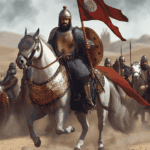
The Battle of Levounion, fought on April 29, 1091, stands as a pivotal moment in Byzantine history, marking the resurgence of imperial power after decades of decline. This decisive victory, achieved by Emperor Alexios I Komnenos against the invading Pechenegs, not only secured the empire’s European territories but also heralded the beginning of the Komnenian restoration.
Background
To understand the significance of the Battle of Levounion, we must first examine the context in which it occurred. The Byzantine Empire had been reeling from a series of catastrophic defeats and internal strife that had severely weakened its position in the preceding decades.
The Battle of Manzikert and Its Aftermath
On August 26, 1071, the Byzantine army suffered a crushing defeat at the Battle of Manzikert in eastern Asia Minor. This loss to the Seljuk Turks led to the deposition of Emperor Romanos IV Diogenes and his replacement by Michael VII Doukas. The new emperor’s refusal to honor the treaty signed by Romanos opened the floodgates for Turkish incursions into Anatolia.
The consequences of Manzikert were catastrophic. By 1080, the empire had lost approximately 78,000 square kilometers of territory in Anatolia, along with a significant portion of its manpower and grain supply. This defeat marked the greatest setback for the Byzantine Empire in its 700-year history up to that point.
Rise of Alexios I Komnenos
It was against this backdrop of defeat and disaster that Alexios Komnenos ascended to the throne on April 4, 1081. A capable general with experience fighting the Turks since his teenage years, Alexios was determined to reverse the empire’s fortunes, regardless of the cost.
The Pecheneg Invasion
In the spring of 1087, alarming news reached Constantinople: a massive Pecheneg invasion was underway. The Pechenegs, a Turkic nomadic tribe from the northwestern Black Sea region, had assembled a force of approximately 80,000 people, including warriors, women, and children.
The Pecheneg horde posed a severe threat to the already weakened Byzantine Empire. Taking advantage of the chaos that had prevailed since the defeat at Manzikert, the invaders plundered their way through the northern Balkans, setting their sights on Constantinople itself.

Byzantine Military Weakness
Years of civil war and neglect had left the Byzantine military in a precarious state. Emperor Alexios found himself without sufficient troops to repel the Pecheneg invasion through conventional means. This dire situation forced him to rely on his diplomatic skills and strategic acumen to save his empire from annihilation. In a shrewd move, he appealed to another nomadic tribe, the Cumans, for assistance against the Pechenegs.
The Cumans
The Cumans were fierce nomadic warriors from the Eurasian Steppe, known for their formidable fighting skills. Alexios offered them gold in exchange for their support against the Pechenegs, a proposal that the Cumans readily accepted. The addition of the Cuman forces would prove crucial in the upcoming battle.
In the late spring of 1091, the Cuman forces arrived in Byzantine territory, joining Alexios and his army. The combined Byzantine-Cuman force began preparations to confront the Pecheneg invaders.

Battle Preparations
On Monday, April 28, 1091, Alexios and his allies reached the vicinity of the Pecheneg camp. The encampment was located at Levounion, near the delta of the Hebros (Maritsa) River in eastern Thrace, close to the town of Enos.
Upon arrival, Alexios announced that the battle would commence the following day. This news spread quickly through the camp, with officers and soldiers alike preparing for the impending conflict. The Byzantine and Cuman forces organized their ranks, forming a solid battle line in anticipation of the engagement.
The Battle of Levounion
As dawn broke on Tuesday, April 29, 1091, the Byzantine-Cuman army assembled at the foot of Levounion, organizing its ranks into a formidable battle formation. Emperor Alexios, clad in his battle regalia, took his position at the forefront of the formation, embodying the strength and resolve of the gathered forces.
The total strength of the Byzantine-Cuman army is estimated to have been around 70,000 men, composed of approximately 20,000 Byzantines, 40,000 Cumans, and 5,000 Vlachs. They faced around 80,000 Pechenegs.
The Pechenegs appear to have been caught completely off guard by the Byzantine-Cuman attack. This element of surprise proved to be a crucial factor in the battle’s outcome.
The battle commenced with a fierce charge led by the Byzantine and Cuman cavalry. The speed and ferocity of the initial assault threw the Pecheneg camp into chaos. Unprepared for the onslaught, the Pechenegs struggled to organize an effective defense.

As the battle progressed, it became evident that the battle was turning into a complete rout of the Pecheneg forces. With their defensive lines shattered and their camp in flames, the surviving Pechenegs began to flee in disarray. However, escape proved nearly impossible as the Byzantine and Cuman forces had effectively surrounded the encampment.
The pursuit of the fleeing Pechenegs was relentless. Byzantine and Cuman warriors chased down the scattered groups of survivors, cutting them down without mercy. The wagon-fort that the Pechenegs had constructed for protection became a death trap, with the Byzantine forces systematically dismantling it and slaughtering those who sought refuge within.
The Byzantine and Cuman forces slaughtered the Pechenegs indiscriminately, killing warriors, women, and children alike. The battle turned into a bloodbath, with the allies butchering the Pechenegs so savagely that they were nearly wiped out entirely.
While exact numbers are not available, sources suggest that the majority of the Pecheneg force was annihilated. Those who survived the initial slaughter were captured by the Byzantines. Many of these survivors were subsequently forced into imperial service, a common Byzantine practice with defeated enemies.

Aftermath
The victory at Levounion immediately secured the empire’s European possessions, eliminating the Pecheneg threat. This allowed Alexios to turn his attention to other pressing matters, including the ongoing struggles in Asia Minor.
The Battle of Levounion marked a turning point in Byzantine history. It was the most decisive victory achieved by a Byzantine army in over half a century and signaled the beginning of a Byzantine resurgence. In the years following Levounion, Byzantine armies began to make significant gains in Asia Minor. They reconquered much of the previously lost territory, including fertile coastal regions and many important cities.
With the restoration of firm central government under Alexios and his successors, the Byzantine Empire entered a period of economic prosperity. Over the next century, the empire grew rich, and Constantinople once again became the preeminent city of the Christian world.




